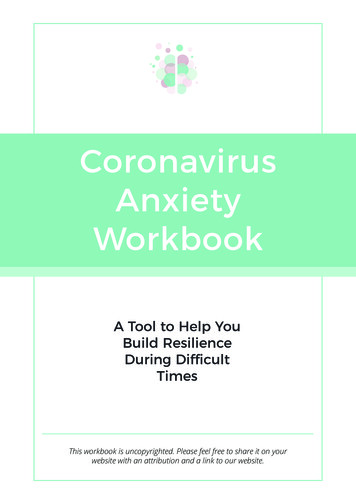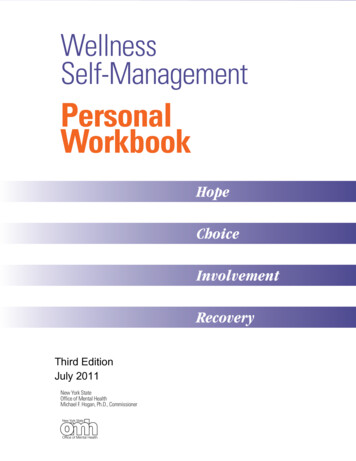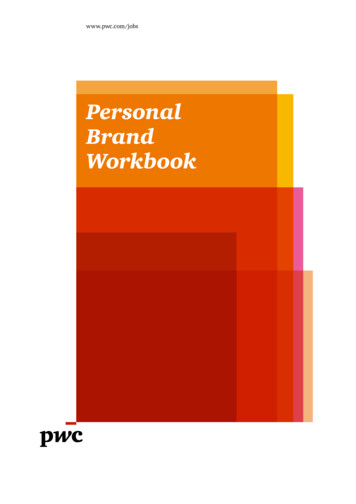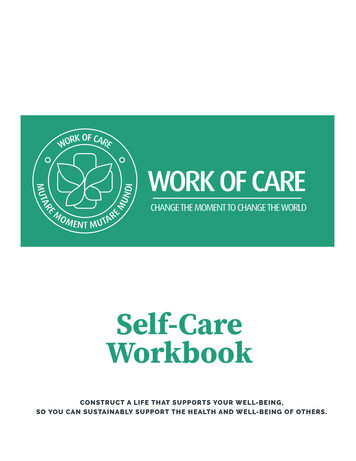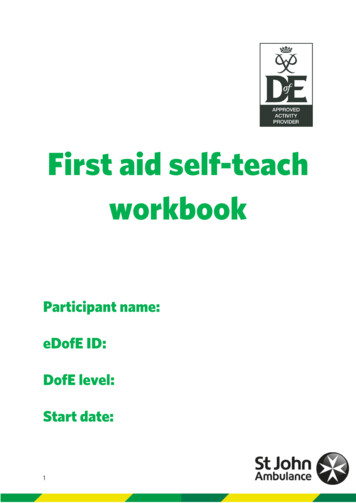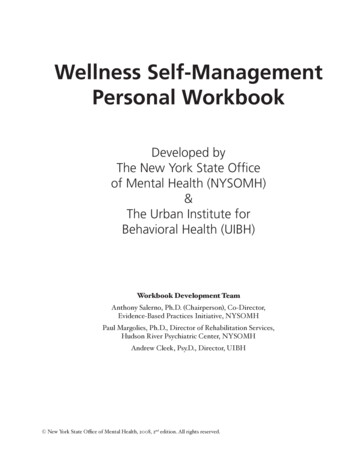
Transcription
Personal Workbook Wellness Self-ManagementPersonal WorkbookDeveloped byThe New York State Officeof Mental Health (NYSOMH)&The Urban Institute forBehavioral Health (UIBH)Workbook Development TeamAnthony Salerno, Ph.D. Chairperson , Co Director,Evidence Based Practices Initiative, NYSOMHPaul Margolies, Ph.D., Director of Rehabilitation Services,Hudson River Psychiatric Center, NYSOMHAndrew Cleek, Psy.D., Director, UIBH New York State Office of Mental Health, 2008, 2nd edition. All rights reserved.1
2 Wellness Self-ManagementACKNOWLEDGEMENTSThe Wellness Self Management WSM PersonalWorkbook was created as a joint effort betweenthe New York State Office of Mental Health (NY SOMH and the Urban Institute for BehavioralHealth UIBH .The initial development of the WSM PersonalWorkbook was made possible through the supportprovided by Sharon Carpinello, R.N., Ph.D., for mer NYSOMH Commissioner. Its continued devel opment, finalization and dissemination have beenmade possible by the active leadership of MichaelHogan, Ph.D., NYSOMH Commissioner.The Workbook Development Team is grateful forthe efforts of Sheetal Rayancha, UIBH administra tive assistant, whose help with the initial draft ofthis Workbook was indispensable. We also give spe cial thanks to Robyn Katz, former Director of theBureau of Adult Community Services, for her exten sive editing of the initial draft.Appreciation is also extended to the following indi viduals for their contributions:Peter Beitchman, D.S.W., Executive Director,The Bridge, Inc.Peter C. Campanelli, Psy.D., President & CEO,The Institute for Community Living, Inc. ICL Cathy Cave, L.C.S.W., Director of Cultural Com petence, NYSOMHAmy Colesante, Office of Recipient Affairs, NY SOMHRosa M. Gil, D.S.W., President & CEO, Comuni life, Inc.Sharon Gold, L.C.S.W., Director of ContinuingDay Treatment, The Bridge, Inc.Chris Keane, F.N.P., ICLHarvey Lieberman, Ph.D., Consultant to ICLBenjamin R. Sher, M.A., L.M.S.W., Director ofTraining, ICLTony Trahan, Office of Recipient Affairs, NY SOMHCaren Weingart, L.C.S.W., Clinical Supervisor,The Postgraduate Center for Mental HealthThis Workbook has been piloted at ten agencies af filiated with UIBH and at Hudson River Psychiat ric Center in Poughkeepsie, New York. The Work book has been shaped by feedback provided by theconsumers, staff and leaders of these organizations.Without their efforts, the Workbook could not havebeen developed.The Workbook includes material that has been re printed or modified with permission from:OMH Office of Recipient Affairs. (2005). Rec ommendations: Infusing Recovery Principles inthe Illness Management & Recovery ResourceToolkit. Albany: New York State Office of MentalHealthRyan, S.W., Littrell, K.H., Sowers, C., & Peabody,D.D. (2003). Solutions for Wellness 2nd ed.) ( EliLilly and Company . Available at www.treatment team.comWeiden, P.J., Scheifler, P.L., Johnson McCrary, K.et al. (2003). Team Solutions (3rd ed . Eli Lillyand Company . Available at www.treatmentteam.comThis Workbook also includes material reprinted ormodified from sources in the public domain. Theseinclude:Mueser, K., and Gingerich, S. (2003). Illness Man agement & Recovery Implementation Resource Kit.Washington, DC: United States Department ofHealth and Human Services, Substance Abuseand Mental Health Services Administration.Available at http://download.ncadi.samhsa.gov/ken/pdf/toolkits/ illness/ 02.IMR Users.pdfOnken, S., and Dumont, J. (2002). Mental HealthRecovery: What Helps and What Hinders? A NationalResearch Project for the Development of Recov ery Facilitating System Performance Indicators.Alexandria, VA: National Technical AssistanceCenter for State Mental Health Planning.
Personal WorkbookThe Workbook represents an adaptation of exist ing open source reports and educational materials,as well as considerable new material created by theWorkbook Development Team. Adaptations gener ally involved changes in language, format, sequenc ing of topics and organization of lessons. Further more, the Workbook was designed to reflect theprinciples of recovery, recognize the role of culturaland religious values, highlight the connection be tween mental and physical health and address thechallenges of providing WSM services in a groupmodality.Most notably, we are indebted to the work of KimMueser, Ph.D., and Susan Gingerich, M.S.W., whodeveloped the comprehensive Illness Managementand Recovery IMR practice and related resourcekit. The WSM Workbook incorporates many of thetopic areas from the IMR resource kit. In addition,the IMR emphasis on a comprehensive curriculumand key clinical practice competencies, such as mo tivational, educational and cognitive behavioral ap proaches, served as the conceptual foundation forthe WSM Workbook and related training materials.The Workbook development team was also influ enced by the Psychiatric Rehabilitation approach 3developed by Dr. William Anthony and colleaguesat Boston University. An adaptation of the ROPESteaching technique forms the foundation for theformat utilized in the Workbook’s lessons.We are grateful for the contributions of the partici pants in the Illness Management and Recovery dis semination project, which received support fromNYSOMH and the Substance Abuse and MentalHealth Services Administration and funds from theRobert Wood Johnson Foundation. Participants’work and feedback heavily influenced the develop ment of this Workbook. Additionally, we appreci ate the thoughtful and constructive feedback ofthe members of several focus groups who reviewedthese materials as they were developed.We also wish to acknowledge the contribution ofEli Lilly and Company, which developed the Solu tions for Wellness and Team Solutions educationalmaterials, disseminated through the University ofMedicine and Dentistry of New Jersey. Some of thematerial was directly incorporated into the Work book, and the development of new material wasguided by the simplicity and clarity of language ofthe Lilly material.Please note: No person or agency may reproduce, reprint or distributethe WSM Workbook without the prior written approval of theNew York State Office of Mental Health. Requests for approval shouldbe directed to wsm@omh.state.ny.us
4 Wellness Self-ManagementWELCOME!Congratulations on your decision to take more control over your life!As current and former recipients of services, we know it takes a lot ofcourage and hard work to make changes. The effects of mental illnesscan make even the simplest of tasks seem very difficult and drain usof our energy and resources. However, as you will learn in the firstchapter, everyone can recover from mental illness and you are incontrol of your own recovery. You are the expert on yourself and noone can tell you what your path to recovery will look like. You willhave to decide what works for you and what doesn’t. Your Workbook isdesigned to help you with these decisions.For many of us traditional treatment has been only a part of ourrecovery. To get the most out of this program, we encourage you todevelop real, authentic relationships by listening to and learning frompeople in your group and from others; to share your experiences withyour peers; to co-lead the group; to find a buddy and to follow throughon your Action Steps. Real life happens outside of the clinic and yourAction Steps will help to make it real for you.You are about to start on an adventure. What you do now willdetermine who you will become.We wish you well on the journey,The Bureau of Recipient AffairsNew York State Office of Mental Health
Personal Workbook 5WELLNESS SELF-MANAGEMENT (WSM)PERSONAL WORKBOOKTable of ContentsIntroductionTopic 1: What Is Wellness Self-Management (WSM) and How Can It Be Helpful to You?Lesson 01 Wellness Self-Management Program Overview . . . . . . . . . . . . . . . . . . . 8Lesson 02 WSM: Important Points . . . . . . . . . . . . . . . . . . . . . . . . . . . . . . 11Topic 2: Getting the Most Out of the WSM ProgramLesson 03 What Is Your Role in the Program? . . . . . . . . . . . . . . . . . . . . . . . . . 14Lesson 04 Understanding Positive and Negative Thinking . . . . . . . . . . . . . . . . . . 17Lesson 05 Getting to Know Each Other . . . . . . . . . . . . . . . . . . . . . . . . . . . . 20Chapter 1: RecoveryTopic 1: What Is Recovery?Lesson 06 Visions of Recovery . . . . . . . . . . . . . . . . . . . . . . . . . . . . . . . . . 22Topic 2: Setting Goals Helps RecoveryLesson 07 Exploring Your Personal Life Goals . . . . . . . . . . . . . . . . . . . . . . . . . 24Lesson 08 Understanding Barriers that Get in the Way of Achieving Goals . . . . . . . . . 27Lesson 09 Using Strategies to Overcome Barriers that Get in the Way ofAchieving Goals . . . . . . . . . . . . . . . . . . . . . . . . . . . . . . . . . . . 30Topic 3: Understanding What Helps and What Hinders RecoveryLesson 10 What Helps Recovery? . . . . . . . . . . . . . . . . . . . . . . . . . . . . . . . 35Lesson 11What Hinders Recovery? . . . . . . . . . . . . . . . . . . . . . . . . . . . . . . 38Lesson 12 Choosing Your Own Recovery Strategies. . . . . . . . . . . . . . . . . . . . . . 40Topic 4: Your Cultural Background and the WSM ProgramLesson 13How Your Cultural, Religious and Family Background Affects theDecisions You Make about Mental Health Treatment. . . . . . . . . . . . . . . 44Topic 5: Personal Strengths and Outside Resources Help RecoveryLesson 14 Recognizing and Using Your Personal Strengths . . . . . . . . . . . . . . . . . . 48Lesson 15Recognizing and Using Your Cultural and Community Resources . . . . . . . . 52Topic 6: Social, Cultural, and Community Supports Help RecoveryLesson 16 Social Supports Help Recovery . . . . . . . . . . . . . . . .Lesson 17 Using Self-Help and Peer Support . . . . . . . . . . . . . .Lesson 18 Connecting to Your Community . . . . . . . . . . . . . . .Lesson 19 Meeting New People . . . . . . . . . . . . . . . . . . . . . .Lesson 20 Getting Closer to People . . . . . . . . . . . . . . . . . . . 55. 59. 61. 64. 66
6 Wellness Self-ManagementChapter 2: Mental Health Wellnessand Relapse PreventionTopic 1: Practical Facts about Mental Health and Mental IllnessLesson 21 Introduction to Practical Facts about Mental Health and Mental IllnessLesson 22 Symptoms of Mental Illness—Part I . . . . . . . . . . . . . . . . . . . .Lesson 23 Symptoms of Mental Illness—Part II . . . . . . . . . . . . . . . . . . .Lesson 24 How Is Mental Illness Diagnosed? . . . . . . . . . . . . . . . . . . . . .Lesson 25 Understanding the Causes of Mental Illness . . . . . . . . . . . . . . . .Lesson 26 Coping with the Stigma of Having a Mental Illness Diagnosis . . . . . . 69. 71. 75. 79. 83. 87Topic 2: Coping with Stress and SymptomsLesson 27 What Is Stress? Why Is It Important to You? . . . . . . . . . . . . . . .Lesson 28 Identifying Your Personal Signs of Stress . . . . . . . . . . . . . . . . . .Lesson 29 How to Prevent Stress in the First Place . . . . . . . . . . . . . . . . . .Lesson 30 Coping with Stress: What Works? What Doesn’t? . . . . . . . . . . . . .Lesson 31Using a Step-by-Step Formula to Improve a Problem . . . . . . . . . . .Lesson 32 Thoughtfully Choosing a Mental Health Problem to Work On . . . . .Lesson 33Choosing Strategies for Coping with Specific Problems and Symptoms .Lesson 34 Checking on Your Progress in the WSM Program . . . . . . . . . . . . . 91. 95. 98101106109. 112120Topic 3: Making Treatment and Mental Health Services Work for YouLesson 35Choosing Types of Mental Health Services that Are Right for YouLesson 36 Practical Facts about Medication . . . . . . . . . . . . . . . . . . .Lesson 37 Understanding Side Effects . . . . . . . . . . . . . . . . . . . . . .Lesson 38 Coping with Side Effects . . . . . . . . . . . . . . . . . . . . . . .Lesson 39 Using Medication Effectively . . . . . . . . . . . . . . . . . . . . .Lesson 40 Working Effectively with Your Doctor . . . . . . . . . . . . . . . . 123.128. 132. 135.138142Topic 4: Relapse Prevention: Developing and Using Your WellnessSelf-Management PlanLesson 41 Relapse Prevention: What Is It? Why Is It Important to You? .Lesson 42 Understanding Your Personal Triggers for Relapse . . . . . . .Lesson 43 Knowing Your Early Warning Signs . . . . . . . . . . . . . . . .Lesson 44 Completing Your WSM Plan: Relapse Prevention . . . . . . . .Lesson 45 Completing Your WSM Plan: Managing a Relapse . . . . . . .145148150.154.156.
Personal Workbook 7Chapter: 3 Living a Healthy Lifestyle andMental Health RecoveryTopic 1: What Is a Healthy Lifestyle and Why Is It Important?Lesson 46 What is the Connection between a Healthy Lifestyle and Mental HealthRecovery? . . . . . . . . . . . . . . . . . . . . . . . . . . . . . . . . . . . . . . .159Topic 2: Using Physical Healthcare Services to Stay HealthyLesson 47 Identifying and Using Your Healthcare Resources . . . . . . . . . . . . . . . . 162Lesson 48 Getting Help for Your Physical Health Problems . . . . . . . . . . . . . . . . 166Lesson 49 Understanding the Most Common Serious Physical Health Problems . . . . . 169Topic 3: Exercising: Fun, Health and FitnessLesson 50 Exercise and Mental Health Recovery . . . . . . . . . . . . . . . . . . . . . . .172Topic 4: Healthy Food and Nutrition: Practical TipsLesson 51Learning Healthier Eating Habits and Mental Health . . . . . . . . . . . . . .175Topic 5: Avoiding and Reducing Unhealthy and Dangerous ActivitiesLesson 52 Understanding How Smoking, Alcohol, Drugs and Unsafe SexMay Hurt Your Recovery . . . . . . . . . . . . . . . . . . . . . . . . . . . . . .177Lesson 53Understanding Pros and Cons: Deciding if Smoking, Alcohol,Drugs and Unsafe Sex is a Problem . . . . . . . . . . . . . . . . . . . . . . . . .181Lesson 54 Making a Decision to Change Unhealthy and Dangerous Activities . . . . . . 184WSM Wrap-UpTopic 1: Wellness Self-Management PlanLesson 55 My Wellness Self-Management Plan . . . . . . . . . . . . . . . . . . . . . . . 188Topic 2: Review of What Has Been LearnedLesson 56 Endings and New Beginnings . . . . . . . . . . . . . . . . . . . . . . . . . . . .191Lesson 57 What Have I Learned? How Has It Affected My Life? . . . . . . . . . . . . . 194Appendix A: Quality of Life Progress Checklist . . . . . . . . . . . . . . . . . . . . . . . 197Good News“Long-term studies have consistently found that half to two-thirds of people diagnosedwith major mental illness go on to a significant or complete recovery. Data show thateven in the second or third decade, a person can still go on to a complete recovery.I believe you can be one of the ones to recover.”Patricia Deegan, Ph.D.Presentation: “I Don’t Think It Was My Treatment Plan That Made Me Well”:Self Directed Recovery and the Role of the Mental Health Professional, 2005
8 Wellness Self-ManagementINTRODUCTIONWELLNESS SELF-MANAGEMENT (WSM)PROGRAM OVERVIEWLESSON 01I M P O R TA N T I N F O R M AT I O N Wellness Self Management WSM is aprogram for people who have had experi ences with mental health problems thathave resulted in disappointments in life.People who participate in this program arelooking to improve their success and satis faction in important areas of life. Throughout this Workbook, you will seethe word RECOVERY. This word is oftenused to mean overcoming drug and alcoholproblems. In this Workbook, you will learnthat the word RECOVERY means some thing different when applied to mentalhealth problems. As human beings we are all involved inmanaging our mental and physical well be ing. Handling stress, solving problems, get ting along with others, coping with disap pointments and keeping a balanced life arepart of everyone’s day-to-day challenges. It’s important that we don’t spend toomuch time and energy managing our men tal and physical health. If we do, then thereis not much time and energy left to accom plish goals and enjoy life. Learning how to manage mental healthproblems frees up time and energy to pur sue goals and enjoy life. For some people, managing mental healthproblems and trying to stay healthy take upa lot of time and energy. In fact, a person’smental health problems could become thecenter of his or her life. A person may for get that he or she is a person with goals,values, strengths, needs, dreams, desiresand talents. Instead, a person may think ofhim or herself as a mentally ill person firstand foremost. Sometimes, the mental health system mayfocus too much on a person’s mental healthproblems and not pay enough attention tothe person’s wants and goals. In the WSM Program, the focus is on youas a complete person first and foremost. Many of the topics in the WSM Programare based on research findings. These find ings show that learning about these topicsand applying what is learned can make adifference in people’s lives.The eight goals of the Wellness SelfManagement Program Learning about recovery and what it canmean for you Making the best use of your mental andphysical health services Learning how mental health and physicalwellness will help you to achieve your goalsand support your personal recovery Staying well by decreasing symptoms of amental health problem Learning how to manage day to day stressand prevent relapse Staying well by connecting with others.
Personal Workbook Staying well by living a healthy lifestyle Recognizing and building on your culturalvalues and experiences to support yourpersonal recovery.Wellness Self Management can be used inindividual or group meetings. These meetingshappen at least once a week and usually last atleast 30 minutes.How this Workbook is organizedThe Workbook has 57 brief lessons that aredivided by topic area into three major chapters: Chapter 1: Recovery9Each of the 57 lessons in the Workbook isdivided into three parts: Important Information: The first sec tion of each lesson introduces the topicand the key facts for thought and discus sion. Personalized Worksheet: The work sheet helps you think in more detail aboutthe information and apply it to yourselfand to your own life. Action Step: The Action Step box asksyou to write down a small step to take thatwill help you learn more about the topicarea or apply it in your own life. Chapter 2: Mental Health Wellness andRelapse Prevention Chapter 3: Living a Healthy Lifestyle andMental Health RecoveryVe r y I m p o r t a n t P o i n t !WSM is a program that covers many different topics.Some of the topics will be very important to you. Youmay want to discuss these topics in greater detail thanthe WSM group can offer. Bringing these topics up inmeetings with other mental health professionals mayhelp you get the most out of the WSM program.
10 Wellness Self-ManagementP E R S O N A L I Z E D W O R K S H E E T:Choosing goals important for youHere are the eight goals of the WSM Program. Please check the boxes next to the goals thatare important for you. It is OK to check as many goals as you like:o Learning about recovery and what it can mean for youo Making the best use of your mental and physical health serviceso Learning how mental health and physical wellness will help you to achieve your goalsand support your personal recoveryo Staying well by decreasing symptoms of a mental health problemo Learning how to manage day to day stress and prevent relapseo Staying well by connecting with otherso Staying well by living a healthy lifestyleo Recognizing and building on your cultural values and experiences to support yourpersonal recovery.Discussion Point:How would accomplishing any of thesegoals make a difference in your life?“Forget past mistakes. Forget failures.Forget everything except what you’re going to do now and do it.”—William Durant, American philosopher
Personal Workbook 11WSM IMPORTANT POINTSLESSON 02I M P O R TA N T I N F O R M AT I O NWhat Wellness self-managementis aboutBuilding o
2 Wellness Self-Management The Wellness Self Management WSM Personal Workbook was created as a joint effort between the New York State Office of Mental Health (NY SOMH and the Urban Institute for Behavioral Health UIBH . The initial development of the WS

